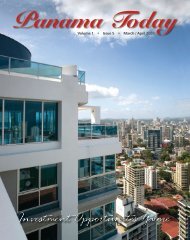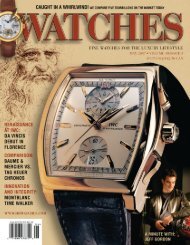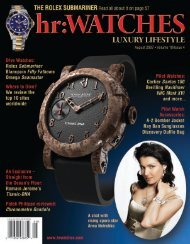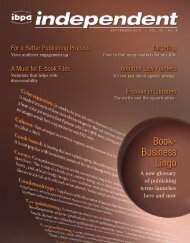Where the Growth Is
Where the Growth Is - Van-garde
Where the Growth Is - Van-garde
- No tags were found...
Create successful ePaper yourself
Turn your PDF publications into a flip-book with our unique Google optimized e-Paper software.
■Pausewith clients over <strong>the</strong> years, it has become clear: Pause powersperformance.A Universal Principle: PauseHow often do we miss <strong>the</strong>se small but significant moments?These key opportunities can unlock our hearts and minds,open us up, and connect us more deeply with o<strong>the</strong>rs so thatwe can create something new and different.All too often, we allow ourselves to be carried away by ourbusyness. We are too hyperactive, too reactive to even notice<strong>the</strong> hidden value-creating dynamics waiting just under <strong>the</strong>surface within us and around us.Leaders we interviewed toldus, We need to pause to figureout what is important and whatis not.Te<strong>the</strong>red to our smartphones, we are too caught up and distractedto take <strong>the</strong> time necessary to sort through complexityor to locate submerged purpose. In our urgent rush to get“<strong>the</strong>re,” we are going everywhere but being nowhere. Far toobusy managing with transactive speed, we rarely step back tolead with transformative significance.Pause is a universal principle inherent in living, creative systems.It is part of <strong>the</strong> order, value, and growth that arise fromslowing down and stepping back. In physics, it is <strong>the</strong> SecondLaw of Thermodynamics: As activity lessens, order increases.The Pause Principle is present in economies, physiologies,ecologies, communities, organizations, and nations. Weobserve pause on <strong>the</strong> macro and <strong>the</strong> micro levels as a principleof life and leadership, a natural part of <strong>the</strong> continuumthat catalyzes growth, innovation, and transformation.As with any valuable resource not yet recognized and <strong>the</strong>reforeneglected, we have to explore and discover its pragmaticuses to experience its value-creating impact. Additionally, weneed to learn to tap into pause, incorporating it in our livesand leadership, and leveraging it as a powerful resource, aninnovation in and of itself.The Pause Principle derives from several years of research,including interviews with more than 100 people, as well asfrom various forms of practice and from observing effects.It entails <strong>the</strong> conscious, intentional process of stepping back,within ourselves and outside of ourselves, to lead forwardwith greater au<strong>the</strong>nticity, purpose, and contribution. Thismethodology allows more examination, higher-order logic,rational analysis, more profound questioning, deeper listening,higher-quality presence, broader perspective, greateropenness to diverse thinking and input, and ultimately moreimpactful, influential, and innovative action.Of <strong>the</strong> 100-plus leaders we interviewed, nearly every one toldus, There is so much coming at us at once, we need to pauseto figure out what is important and what is not. Pause Points,whe<strong>the</strong>r structured or spontaneous, can help us do that. Theyare tools to help us regain our balance, feel grounded andcentered. They can help us be accountable to our commitments,to our mission, and to people. Pause Points can helpus intentionally imbue generativity, innovation, and a senseof meaningful service in our cultures.The Pause PracticesFrom our interviews and our analyses of a multitude ofresearch and case studies, we have isolated Seven Pause Practicesthat support <strong>the</strong> meta-pause principle: Step back to leadforward. The practices are <strong>the</strong> pragmatic ways to brea<strong>the</strong> lifeinto each growth area: grow self, grow o<strong>the</strong>rs, grow culturesof innovation.➤ Pause Practice 1: Be On-Purpose“Leaders remind people what is important,” in <strong>the</strong> wordsof Warren Bennis, <strong>the</strong> leadership studies pioneer. Meaninginspires us to go beyond what is, to contribute somethingextraordinary. Purpose is <strong>the</strong> intersection of competency andcontribution that aspires to achieve something bigger, somethingbeyond us. Purpose gives context, drive, and meaningto personal growth, talent growth, and growth of innovation.It may be <strong>the</strong> most important, most far-reaching, transformativepause of all.➤ Pause Practice 2: Question and ListenQuestions are <strong>the</strong> probing language of pause, forcing us to stepback, reframe, revision, and reconsider. Questions are <strong>the</strong> learninglinks that, over time, connect knowing to wisdom. Questionsare <strong>the</strong> spades of curiosity that allow us to dig deeperfoundations for personal, relational, and creative growth.Listening is <strong>the</strong> receptive language of pause. Listening withau<strong>the</strong>nticity opens up doorways to self-knowledge, understandingo<strong>the</strong>rs, and innovative possibilities; it introducesus to new ways of thinking, behaving, and seeing <strong>the</strong> world.34 | IBPA Independent | February 2013








